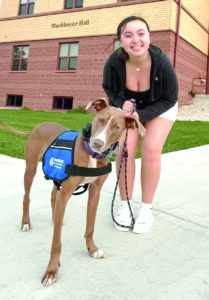By Dr. Beth Leermakers
“Jazzy is probably too rambunctious for children,” I said. I’m glad I’m not a betting woman. Affectionately nicknamed “Spazzy Jazzy” by her trainer, my 8-month-old former foster puppy turned out to be wonderful with children. In fact, she’s so gentle with kids, and so well-behaved in public, that she was accepted into a training program to become a service dog for an autistic child.

Photo courtesy of Beth Leermakers
Jazzy’s story is truly remarkable because Pawsitism, the group I work with, usually gets their service dog candidates as young puppies from breeders. Jazzy is a mixed-breed pup who wound up on the euthanasia list at the Fort Worth shelter because she had an upper respiratory infection and the medical ward was full. Now she’s undergoing training to help an autistic child navigate the scary world.
Service dogs are skilled companions who perform specific tasks to assist people with disabilities. According to the official Americans with Disabilities Act (ADA) requirements, service dogs must be individually trained to do work or perform tasks for a person with a disability. Service dogs are working dogs, not just pets. Federal law protects a person’s right to use a service animal in any public place.
Emotional support dogs provide comfort and improve their person’s well-being, but they do not receive extensive training to perform specific activities related to a disability or medical condition. Although they are allowed in airplane cabins, emotional support dogs are not granted access to all public places like service dogs are.
Types of
Service Dogs
Service dogs can be trained to perform a variety of tasks:
Guiding people who are blind or visually impaired. Guide — or seeing eye — dogs navigate their handlers safely through crowds and public spaces, across streets and around obstacles. Unlike other service dogs, seeing eye dogs are taught “intelligent disobedience.” They are trained to ignore a command that would jeopardize the team’s safety, such as crossing the street against oncoming traffic or a command to step off a vacant subway platform.
Alerting people who are deaf or hard of hearing. Hearing dogs alert their handlers to sounds and signals such as voices, doorbells, oven timers, fire alarms or approaching vehicles. Hearing dogs are trained to alert their person to the sound through a gentle nudge or paw, and then lead them to safety or the source of the sound.
Providing physical assistance. Also known as mobility support or mobility assistance dogs, physical assistance dogs are trained to perform tasks like object retrieval, opening/closing doors, turning lights on or off, balance support, and other daily activities like dressing and undressing.
Detecting allergens. Allergy detection dogs are trained to identify specific allergens and alert their handler of dangers that may be present in their food or environment. Their excellent sense of smell allows dogs to sniff out tiny amounts of allergens (such as peanuts or gluten) that pose a risk of serious health complications.
Detecting and responding to specific medical conditions. Diabetic alert dogs are trained to detect changes in blood sugar levels, while seizure alert dogs are trained to detect an oncoming seizure, giving their handlers time to take medication, get to a safe place, or call for help if needed.
Assisting people with mental health issues such as post-traumatic stress disorder (PTSD), anxiety or depression. Psychiatric service dogs are trained to identify the signs of oncoming mental health episodes and provide support such as waking their handlers from nightmares or being a grounding influence during anxiety attacks. According to research conducted by the Department of Veterans Affairs (VA), veterans with PTSD who were paired with service dogs showed less suicidal ideation and more improvement in mental health.
Supporting individuals on the autism spectrum. Autism service dogs are trained to perform tasks that help their handlers manage issues like sensory overload or handle social interactions. These dogs may learn to recognize and interrupt self-harming behaviors or perform a calming act.
Canine Companions provides service dogs to adults, children and veterans with disabilities.
Canine Companions does not provide guide dogs. Their dogs and all follow-up services are provided at no cost to their clients.
Canine Companions’ service dogs (Golden Retrievers, Labrador Retrievers and crosses) are bred to be calm, reliable and affectionate, and they receive extensive training. Each Canine Companions service dog spends the first 18 months with a volunteer puppy raiser to learn basic tasks and socialize in public and private settings. Once the puppy raiser returns the puppy to Canine Companions, the dog enters professional training at a regional training center for five to nine months, where they learn the advanced commands that support the work of a service dog. After they complete professional training, the dogs are matched with people with disabilities, who attend a two-week group training class.
Visit canine.org to learn more.
